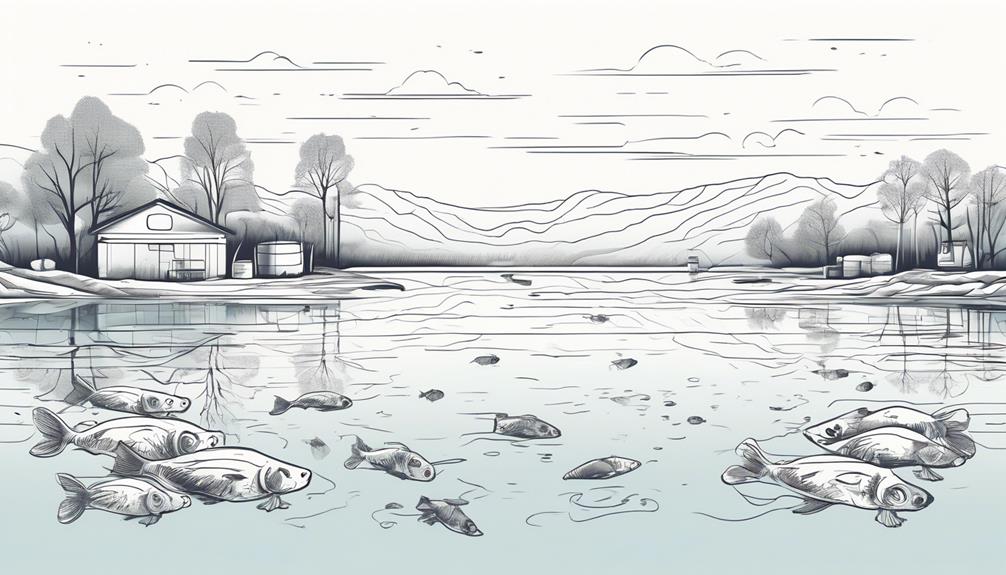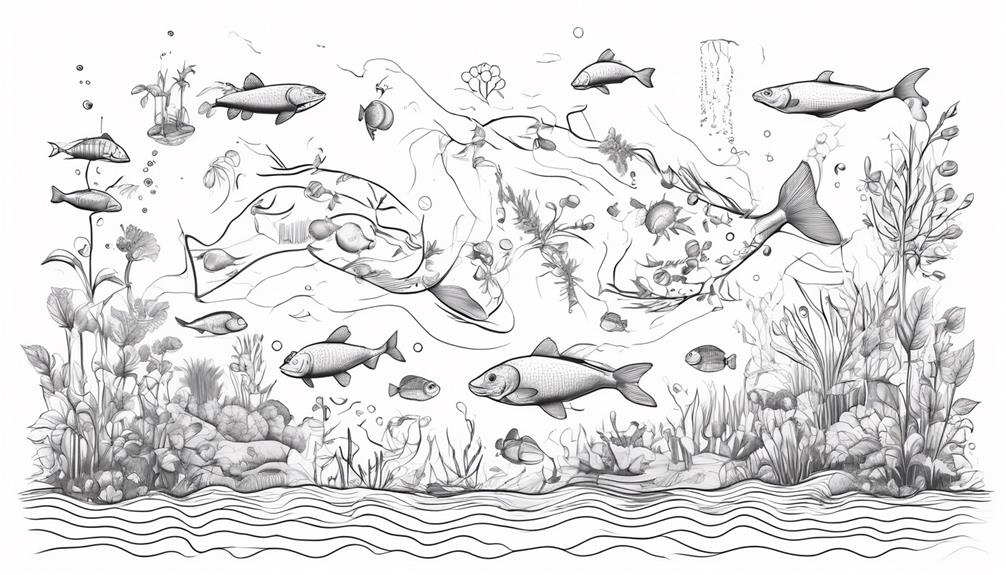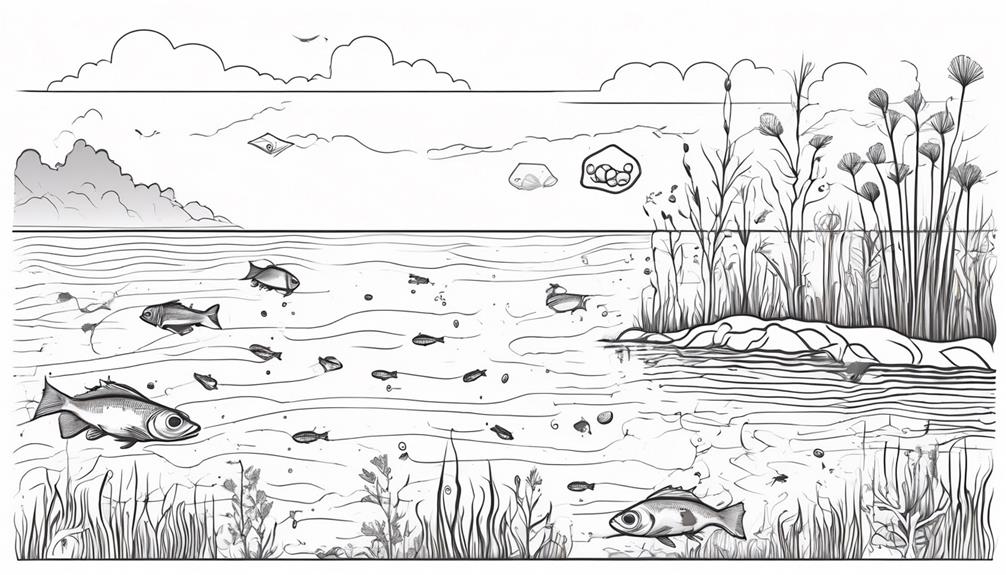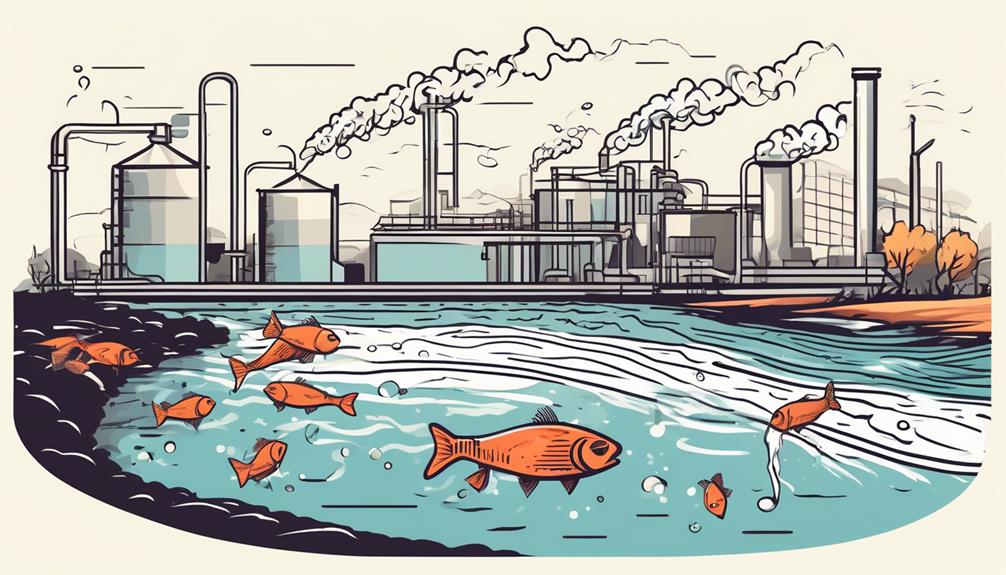Imagine a scenario where pesticides sprayed on crops find their way into nearby water bodies, contaminating the very source of life. This is just one of the ways these chemicals contribute to water pollution.
From seeping into groundwater to causing toxicity in aquatic ecosystems, pesticides pose a significant threat to our water quality.
Understanding these top 10 ways pesticides impact our water systems is crucial for safeguarding the environment and our health.
Key Takeaways
- Pesticides runoff from agriculture and industries contaminate surface water, leading to groundwater contamination and health risks.
- Pesticides seep into the ground, impacting aquifers, soil, and posing risks to the environment and human health.
- Pesticides infiltrate soil, impacting groundwater quality, and their behavior in soil is crucial to prevent pollution.
- Pesticides cause fatalities in aquatic life, disrupt ecosystem balance through bioaccumulation, and affect public health in the long term.
Pesticides Runoff Into Water Bodies
When pesticides runoff into water bodies, they can severely impact aquatic ecosystems and pose significant health risks to humans due to long-term exposure to low pesticide concentrations.
This runoff, mainly from agricultural activities and industrial wastewater, leads to pesticide contamination in surface water, affecting groundwater quality as well.
As pesticides enter water bodies through point and non-point sources, they contribute to water pollution, creating a concerning cycle of environmental and health hazards.
The continuous use of pesticides not only contaminates water but also fosters the development of resistant pest strains, exacerbating the issue.
To combat this problem, advanced oxidation processes serve as effective treatment methods to reduce pesticide contamination in water bodies.
Understanding the detrimental effects of pesticides in water is crucial for safeguarding both aquatic life and human well-being, emphasizing the importance of implementing sustainable practices to mitigate pesticide runoff and preserve water quality.
Groundwater Contamination by Pesticides
When pesticides seep into the ground, they can impact aquifers, leach into soil, and result in toxic chemical runoff.
Imagine these harmful substances infiltrating the earth, spreading their toxins and affecting the water you drink.
The process is intricate, but the consequences are straightforward – contamination that poses risks to both the environment and human health.
Impact on Aquifers
Pesticides contribute to water pollution by contaminating aquifers through leaching, posing significant risks to groundwater quality and ecosystem health. This contamination occurs when pesticides seep through the soil into groundwater sources, affecting both aquatic life and human health. Factors like soil properties and pesticide application rates influence the extent of this pollution, making it a complex issue to address.
Some pesticides bind tightly to soil particles, decreasing their movement and increasing the likelihood of reaching aquifers. Cleaning up groundwater contaminated by pesticides is challenging and can have lasting repercussions on water quality and ecosystems. The impact of pesticide pollution on aquifers highlights the urgent need for better management practices to safeguard our water sources and overall well-being.
Leaching Into Soil
Curiously exploring how pesticides infiltrate soil, endangering groundwater with contamination is essential for understanding the risks to water sources. Pesticides can leach into the soil, impacting groundwater quality. Factors such as the type of pesticide, soil composition, and application methods influence the behavior of pesticides in the environment.
Some pesticides may bind tightly to soil particles, reducing their mobility and increasing the risk of groundwater contamination. The infiltration rate of pesticides into the soil plays a crucial role in determining the extent of contamination.
Contamination of groundwater by pesticide residues can occur through seepage, accidental spills, or improper disposal practices. Understanding the pathways through which pesticides move from soil to water sources is vital for preventing further pollution.
Toxic Chemical Runoff
Infiltrating silently through the layers of soil, toxic chemicals from pesticides pose a grave threat to groundwater quality, complicating cleanup efforts and endangering water sources. Here are some key points to consider about toxic chemical runoff from pesticides:
- Leaching Challenge: Factors like application amount and soil properties can influence pesticide leaching into groundwater.
- Various Contamination Routes: Pesticides can contaminate groundwater through runoff, atmospheric loss, and direct leaching.
- Soil Binding Impact: Some pesticides strongly bind to soil, reducing mobility and increasing the risk of groundwater contamination.
- Private Well Vulnerability: Private wells, not regulated under the Safe Drinking Water Act in the U.S., are susceptible to pesticide contamination.
- Cleanup Complications: Cleanup of pesticide-contaminated groundwater can be challenging or even impossible, impacting environmental and public health.
Pesticide Residues in Water Sources
Pesticide residues lurking in water sources pose a significant threat to water quality and health due to runoff and industrial wastewater contamination. These residues, originating from various sources like agricultural areas and pest control activities, can seep into water bodies, leading to water pollution. The Environmental Protection Agency highlights that long-term exposure to even low pesticide concentrations in water can have adverse effects on both humans and aquatic life. To combat this issue, advanced oxidation processes are effective for removing pesticide residues from water sources.
It is essential to monitor pesticide levels in water sources diligently to ensure water quality and safeguard public health. Pesticides from urban use, agricultural activities, and production factories can enter water bodies through both point and non-point sources, further exacerbating the problem. By addressing the presence of pesticide residues in water sources, we can take a crucial step in protecting the environment and public health from the dangers of water pollution.
Impact of Pesticides on Aquatic Life

When pesticides enter water bodies, they can have devastating effects on aquatic life.
Aquatic biodiversity suffers as pesticides disrupt the delicate balance of ecosystems.
The quality of water declines, impacting the health and survival of various aquatic organisms.
Aquatic Biodiversity Impact
The devastating impact of pesticides on aquatic life reverberates throughout the delicate balance of underwater ecosystems, posing significant threats to biodiversity and the health of local water systems. Here's why pesticide pollution harms aquatic biodiversity:
- Toxic Effects: Pesticides can have toxic effects on aquatic life, leading to fatalities in fish, plants, and aquatic insects.
- Disruption of Ecosystem Balance: Pesticide pollution in water bodies can disrupt the balance of aquatic ecosystems and cause developmental issues in aquatic creatures.
- Ripple Effects: The toxic effects of pesticides on aquatic biodiversity can have ripple effects, impacting the overall health of the local ecosystem.
- Health Risks: Contaminated water sources due to pesticide pollution pose potential risks to the health of aquatic organisms and human consumers.
- Long-term Exposure: Long-term exposure to low pesticide concentrations in water can pose serious health risks to aquatic life.
Water Quality Degradation
Water quality degradation due to pesticide contamination can significantly impact the delicate balance of aquatic ecosystems, affecting the health and diversity of underwater life. Pesticides in soil can seep into surface water resources, introducing pesticide compounds that harm aquatic organisms. The occurrence and behavior of pesticides released into streams can have detrimental effects on aquatic life, leading to decreased biodiversity. Groundwater is also at risk from pesticides annually applied to agricultural lands, posing a potential threat to the quality of water sources. Monitoring and managing pesticide levels are crucial steps to safeguard aquatic ecosystems and preserve the well-being of underwater species.
| Pesticides in soil | Pesticides in surface water resources |
|---|---|
| Pesticide compounds harming aquatic life | Impacting aquatic organisms' health |
| Potential groundwater contamination | Decreased biodiversity in aquatic ecosystems |
Ecosystem Disruption Effects
Pesticides frequently disrupt aquatic ecosystems by causing toxic effects on various forms of underwater life, leading to detrimental consequences for the entire ecosystem. When pesticides contaminate water sources, aquatic life can suffer greatly. Here's why this is a pressing issue:
- Fatalities: Pesticides in water can lead to the death of fish, plants, and aquatic insects.
- Developmental Issues: Aquatic creatures may experience growth and developmental problems due to pesticide pollution.
- Ecosystem Balance: Pesticides disrupt the delicate balance of ecosystems by harming one organism, affecting the entire aquatic system.
- Human Health Risks: Pesticide contamination not only harms aquatic ecosystems but can also pose health risks to humans.
- Drinking Water Contamination: Pesticides in water sources can contaminate drinking water, potentially endangering human health.
Bioaccumulation of Pesticides in Water

With each step up the food chain, pesticides quietly accumulate in the bodies of organisms, posing risks to both wildlife and human health. Pesticides from agricultural land and urban areas make their way into water sources, where they are absorbed by aquatic organisms. As these organisms are consumed by predators, the pesticides bioaccumulate in their bodies, reaching higher concentrations. This bioaccumulation of pesticides in water can have detrimental effects on both the ecosystem and public health. Long-term exposure to low levels of pesticides through contaminated drinking-water supplies can lead to various health issues. The persistence of pesticide bioaccumulation in water can disrupt the balance of aquatic life and impact human consumption of contaminated organisms.
| Effects | Details |
|---|---|
| Health Risks | Long-term exposure can lead to adverse effects |
| Ecosystem Disruption | Disrupts the balance of aquatic life |
| Food Chain Impact | Affects human consumption of contaminated organisms |
| Public Health | Contaminated drinking-water supplies pose risks |
Pesticides Persistence in Water Systems
Pesticides stick around in water systems for a long time, posing a threat to aquatic life. They can be toxic to fish and other organisms, disrupting the delicate balance of ecosystems.
The effects of pesticides can linger for years, leading to long-term contamination and environmental damage.
Toxicity in Water
Leaching into groundwater and persisting for years, pesticides pose a significant long-term toxicity risk to water systems. Here are some key points about the toxicity of pesticides in water:
- Pesticides can contaminate drinking-water supplies, posing a health risk to the public.
- The environmental impact of pesticides on aquatic organisms is severe and long-lasting.
- Water pollution from pesticides can have detrimental effects on the ecosystem.
- The toxicity of pesticides in water systems is influenced by various factors, such as their chemical properties and additives.
- Treating water contaminated with pesticides often requires advanced oxidation processes to ensure safe water quality.
Impact on Ecosystems
Persisting for years in water systems, the presence of pesticides can significantly disrupt the delicate balance of aquatic ecosystems, impacting the flora and fauna that rely on these habitats for survival. Pesticides in water can lead to long-term contamination, affecting streams and other water bodies. This contamination not only harms aquatic life but also has far-reaching consequences for public health and the environment. The toxic nature of these chemicals can cause bioaccumulation and biomagnification, posing risks to organisms throughout the food chain. The environmental impact of pesticides in water systems is profound, highlighting the need for stricter regulations and sustainable agricultural practices to mitigate the detrimental effects on ecosystems.
| Impact of Pesticides on Ecosystems |
|---|
| Disruption of aquatic ecosystems |
| Long-term contamination of water bodies |
Long-Term Contamination Effects
Infiltrating water systems over extended periods, the lingering presence of pesticides can have lasting detrimental effects on both the environment and public health. Here are some key points to consider about the long-term contamination effects of pesticides in water systems:
- Pesticides can persist in water systems for years, contributing to chronic contamination.
- Long-term exposure to low pesticide concentrations in water poses health risks and ecological harm.
- This persistence can significantly impact aquatic ecosystems in streams and groundwater.
- Advanced oxidation processes are effective for treating water contaminated with persistent pesticides.
- Continuous monitoring and research are essential for developing effective mitigation strategies to safeguard public health and the environment.
Pesticides Leaching Into Water Tables
Pesticides seep into groundwater from various sources, potentially contaminating drinking water supplies. The process of pesticides leaching into water tables occurs when these substances move through the soil particles and reach the underground water reservoirs. This can lead to the contamination of ground water, affecting the quality of drinking water and ecosystems. Factors such as soil properties, pesticide application amounts, and land-use practices influence the extent of leaching. Proper pesticide use and disposal methods, along with sustainable farming practices, are essential in preventing pesticides from leaching into water tables. Groundwater contamination by pesticides poses significant risks to human health, necessitating continuous monitoring and management strategies. By understanding how pesticides interact with the environment and implementing best practices, we can work towards reducing the impact of pesticides on water pollution.
| Factors Influencing Pesticides Leaching | Prevention Measures for Pesticides Leaching | Risks of Groundwater Contamination |
|---|---|---|
| Soil properties, application amounts, land-use practices | Proper pesticide use and disposal, sustainable farming practices | Risks to human health, impacts on water quality |
Toxicity of Pesticides to Water Ecosystems

After pesticides leach into water tables, their harmful effects extend to water ecosystems, impacting aquatic life due to their toxic properties. Here are some key points to consider regarding the toxicity of pesticides to water ecosystems:
- Health Risks: Long-term exposure to low concentrations of pesticides in water can pose health risks to aquatic life.
- Contamination: Pesticides can contaminate water sources through runoff and industrial wastewater, affecting the quality and safety of water.
- Fatalities: The toxic effects of pesticides on aquatic life can lead to fatalities in fish, plants, and aquatic insects, disrupting the balance of water ecosystems.
- Treatment Methods: Advanced oxidation processes are effective methods for treating water contaminated with pesticides, safeguarding water quality and aquatic life.
- Ecosystem Disruption: Harmful chemicals from pesticides can disrupt the natural balance of water ecosystems, impacting public health and biodiversity.
Understanding the impact of pesticides on water ecosystems is crucial in preserving the health of aquatic life and maintaining water quality.
Pesticides Transport in Waterways
Upon reaching waterways, pesticides swiftly travel through runoff and industrial wastewater, significantly contributing to water pollution. The transport of pesticides in waterways is a concerning occurrence, with these chemicals easily finding their way into streams and rivers.
According to the USGS assessment, the presence of pesticides in water bodies is alarmingly high, posing risks to aquatic life and human health. Once pesticides enter waterways, they can contaminate the water, affecting not only the immediate environment but also potentially spreading to larger bodies of water.
Factors like rainfall and soil properties play a crucial role in how pesticides move through water systems, making it essential to consider these variables when assessing the impact of pesticide transport.
To mitigate the negative effects of pesticide transport in waterways, it's vital to promote responsible pesticide use, proper disposal methods, and stringent regulatory measures to safeguard water quality for all.
Regulatory Challenges in Pesticide Control

Navigating the intricate landscape of pesticide control poses regulatory challenges that demand careful consideration and collaboration among governing bodies worldwide. In the realm of pesticide regulation, several key challenges arise:
- Varying Regulatory Stringency: Different regions have differing levels of pesticide regulation, making it challenging to create a unified global approach.
- Stringent Evaluation Processes: Pesticides undergo rigorous evaluation and re-evaluation periodically to ensure their safety for public health and the environment.
- Multiple Regulatory Bodies: Entities like Health Canada, U.S. EPA, and the European Commission are responsible for evaluating and regulating pesticides, adding layers of complexity.
- Criteria Complexity: Regulatory criteria encompass a wide range of factors, including human health effects, ecological risks, and safety assessments, contributing to the complexity of oversight.
- Private Well Oversight Gap: The Safe Drinking Water Act in the U.S. doesn't regulate pesticides in private wells, leaving a gap in monitoring and protection efforts for groundwater contamination.
These challenges highlight the intricate and multifaceted nature of pesticide regulation and the critical need for robust oversight to safeguard public health and environmental integrity.
Frequently Asked Questions
How Does Pesticide Contribute to Water Pollution?
Pesticides contribute to water pollution by contaminating water sources through runoff or improper disposal. This contamination poses health risks due to exposure to low pesticide concentrations. Proper disposal and prevention strategies are crucial for protecting water quality.
What Problems Are Caused by Pesticides in Water?
When pesticides infiltrate water, they spawn a toxic brew. Your health, hormones, and habitat suffer. From reproductive woes to intelligence decline, they wreak havoc on ecosystems. Safeguarding water quality demands vigilant oversight and responsible disposal.
What Are 3 Ways Pesticides Impact the Environment?
Pesticides impact the environment by harming wildlife, disrupting ecosystems, and posing health risks to humans. Runoff and wastewater carry pesticides into water sources, contaminating them. Proper disposal and treatment methods are vital for reducing water pollution.
How Are Pesticides Harmful to the Ocean?
Pesticides harm the ocean by contaminating water, endangering marine life. Long-term exposure to low pesticide levels poses risks to aquatic ecosystems. Treatments like advanced oxidation can help combat this issue, preserving biodiversity and the health of marine organisms.
Conclusion
So, you've learned about the top 10 ways pesticides contribute to water pollution.
Now, imagine a world where our water sources are free from harmful chemicals.
How can we work together to ensure clean and safe water for generations to come?
Let's take action and protect our precious water resources.
Together, we can make a difference!
